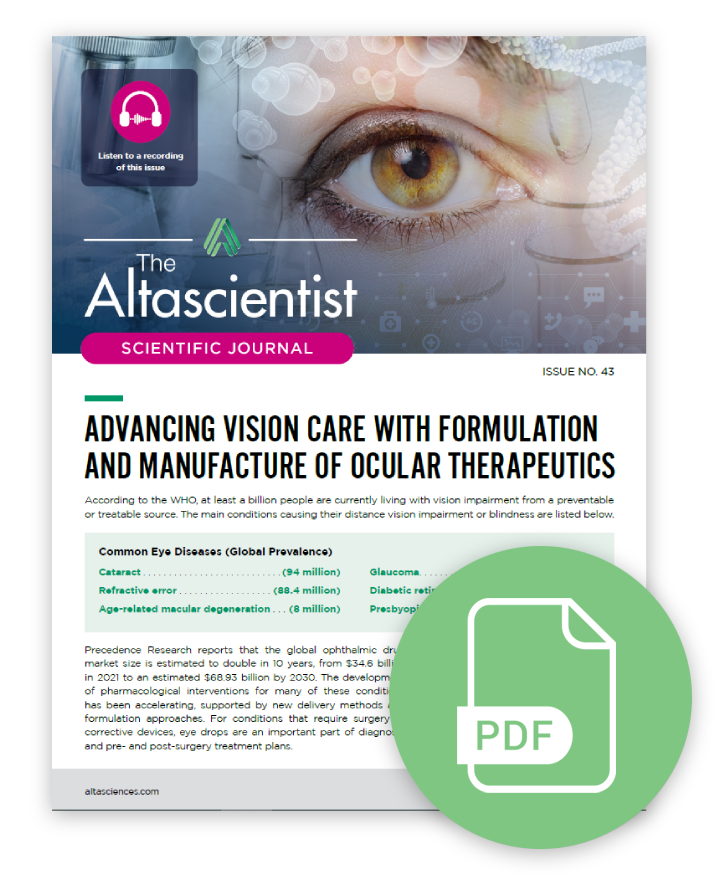Preclinical Research
Best Practices for Preclinical Dose Range Finding Studies
Dose range finding (DRF) studies are the foundation of preclinical drug development, providing crucial information on safety data to assist in the dose level selection before advancing into to
Altasciences’ Ophthalmic Expertise: A Conversation with Dr. Simone Iwabe, DVM, PhD, DACVO and Randy Wheeland, BS

As a leading partner in ocular therapy, Altasciences has been at the forefront of ophthalmic drug development for over 30 years, having completed more than 100 ocular studies to assess the safety of new drug products intended for human use.
ISSUE NO. 43 — Advancing Vision Care With Formulation and Manufacture of Ocular Therapeutics
According to the WHO, at least a billion people are currently living with vision impairment from a preventable or treatable source. Precedence Research reports that the global ophthalmic drug market size is estimated to double in 10 years, from $34.6 billion in 2021 to an estimated $68.93 billion by 2030.
that the global ophthalmic drug market size is estimated to double in 10 years, from $34.6 billion in 2021 to an estimated $68.93 billion by 2030.
The development of pharmacological interventions for many of these conditions has been accelerating, supported by new delivery methods and formulation approaches. For conditions that require surgery or corrective devices, eye drops are an important part of diagnosis, and pre- and post-surgery treatment plans.
In Issue 43 of The Altascientist, we explore key considerations for ophthalmic product manufacturing, including formulation, scalability, regulatory compliance, and quality control:
- Recent developments in ophthalmic medications
- Unique barriers for drug delivery to the eye
- Common types of ocular formulations
- Formulation for effective ocular drug delivery
- Systemic exposure of topical ophthalmic preparations
- Ocular gene therapy
- Manufacturing ocular drugs for clinical trials and commercialization
- A case study
THE CHALLENGES OF OCULAR DRUG DELIVERY
The eye has natural anatomical barriers that restrict the amount of medication reaching its intended target. These include the cornea’s outer layer, the conjunctiva, and the blood-aqueous and blood-retinal barriers. These structures resist water-based drugs, limit absorption, and tightly regulate what enters the inner eye. Additionally, the eye's rapid tear film turnover continuously flushes out medication. These barriers pose challenges for effective treatment—challenges that formulation specialists are striving to address with different formulation options.
SYSTEMIC EXPOSURE OF TOPICAL OPHTHALMIC PREPARATIONS
Ophthalmic topical medications are highly concentrated and can be absorbed systemically due to the passage of medication through the nasolacrimal duct into the highly vascular nasal mucosa. Systemic exposure to eye drops occurs when the active ingredients in the drops are absorbed into the bloodstream.
This can happen through the tear duct, the conjunctiva, or the skin around the eyes. Systemic exposure can produce side effects, which formulation scientists work to minimize. Systemic exposure to ophthalmic medications is influenced by several factors, including the high concentration of active ingredients in eye drops, administration techniques that impact absorption, and patient populations, such as infants, pregnant or nursing women, and the elderly are more susceptible to systemic side effects.
HOW CAN ALTASCIENCES HELP
With a deep understanding of regulatory requirements for ophthalmic formulations and cutting-edge manufacturing techniques, Altasciences provides comprehensive services tailored to meet the highest industry standards for your ophthalmic drug development program. We offer customized solutions that align with your specific needs, delivering an optimized suite of services to deliver high-quality ophthalmic drugs for clinical trials or commercial use.
Explore all issues of The Altascientist in our Resource Center. And don’t forget to subscribe to “The Altascientist: Audiobooks” on Spotify, Apple Podcasts, or wherever you get your audio content.
Download publicationSubretinal Injection of Sodium Iodate Creates a Geographic Atrophy-Like Model in Nanopigs™
Evaluation of Formulation pH Tolerability in New Zealand White and Dutch Belted Rabbits Post-Intravitreal Administration
A 13-Week Dermal Toxicity Study of VIM-004 Gel, a STAR Particles Based Formulation in Göttingen Minipigs®
Targeted Gene Therapy for CNS Disorders: Precision of Intra-Cerebroventricular (ICV) Delivery and Post-Administration Behavioral Assessments in Mice
Bestrophin-Like Lesions Described in Dutch Belted Rabbits
Standardization and Harmonization of Altasciences Historical Control Database Development Using Certara SEND Explorer® for Integrated Toxicological Evaluation
Gene Therapy Studies and Germline Integration Assessment in Nonhuman Primates